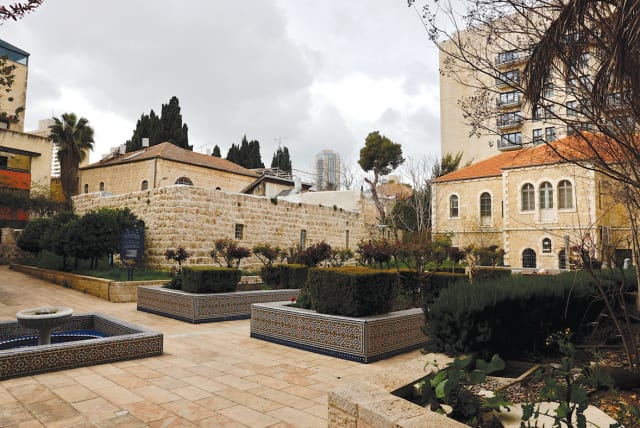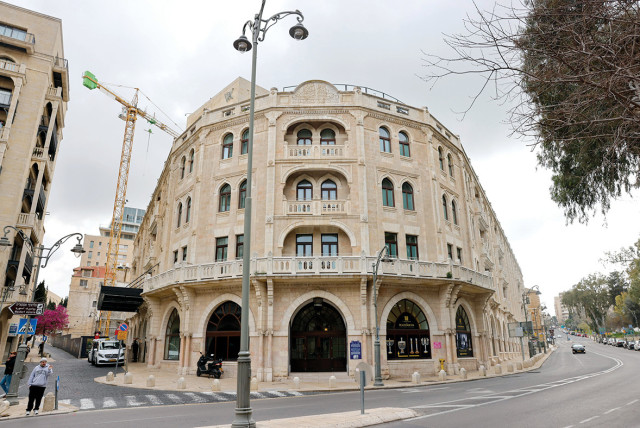A street of many tales: A tour sheds light on Jerusalem's Agron Street

The twisting turning tales of Jerusalem, particularly of the environs of Agron Street, make for intriguing, compelling, and entertaining listening and viewing.

Most city dwellers, it is safe to say, largely just aim to get from point A to point B as efficiently and calmly as possible. But taking a little time to ingest something about the buildings we pass so often, hardly aware they are there, could enhance the commuter experience and improve the quality of urban life as a whole.
The annual Open Houses event certainly offers advantages in that department. Take, for instance, the History on Agron Street Hebrew-language guided tour due to take place on April 6 and 13 under the practiced and entertaining aegis of Rafi Kfir.
Kfir has been on the Jerusalem tour guide scene for over 30 years. Born and bred in the capital – with a protracted hiatus up north thereafter – he has been enlightening folk about some of the historical facts and folklore subtexts that underpin neighborhoods and edifices around the capital in irrepressible style.
The history of Jerusalem
His enthusiasm for the city and its historical backdrop is evident from the off, when we meet up at Paris Square at the junction of Keren Hayesod Street, Ramban Street, King George Street, Azza Street and, more to the point, Agron Street.
It is the latter that forms the main artery – in both a physical and topical sense – of Kfir’s slot in the forthcoming edition of Open Houses, which encompasses a full 152 tours and activities all around the city across two weekends – April 4-6 and 11-13. Some require prior registration on the Open Houses website, while others will operate on a first come first served basis. All events are free.
Kfir starts out by telling me – somewhat superfluously – that Agron Street was named after Gershon Agron, the founder and first editor-in-chief of The Jerusalem Post – then called The Palestine Post. A seasoned raconteur, Kfir regales me with colorful anecdotes of Agron’s political travails when he served as mayor of Jerusalem in the late 1950s, and the infighting shenanigans that brought about his fall from mayoral grace.
In fact, History on Agron Street strays a little beyond the strict confines of the thoroughfare in question.
“This is a very important spot,” Kfir informs me before we leave Paris Square and its fetching fountain.
“Look over there at Terra Sancta,” he says, pointing to our right, to the imposing edifice on the corner of Azza and Keren Hayesod streets. I remembered visiting it in the early 1980s, when it housed the British Library, then run by the British Council. I recalled the enticing “olde worlde” ambiance of the interior and the magnificent staircase with its ornate balustrade.
The exterior isn’t bad either, combining elements of Italian Renaissance with Oriental features.
“Terra Sancta was built by a Christian organization from Milan [Italy], and the statue you see up there on the roof is not the Madonna, it is the Madonnina, a replica of the statue which stands on the Milan Cathedral,” Kfir explains.
I learn that the building was designed by a celebrated Italian architect named Antonio Barluzzi, whose impressive portfolio in this part of the world includes the pilgrimage churches at the Garden of Gethsemane, Mount Tabor, the Mount of Beatitudes, and at the tomb of Lazarus in Bethany. No wonder he was known as the “Architect of the Holy Land.”
Oh, and the Hebrew University also did time in the building, as did the National Library.
KFIR IS an inexhaustible fount of information and amusing asides.
“The municipality of Paris announced it was giving a present, to mark the 40th anniversary of the unification of Jerusalem [in 2007], a 27-meter-high model of the Eiffel Tower,” he chips in. “It never happened,” he laughs. “I don’t know why, but it didn’t work out. Probably someone objected.” That’s probably for the best. A steel girder structure of those dimensions, however alluring it may have been for Francophiles and fans of the City of Light, would have resulted in a radical change to the aesthetics and dynamics of the square and entire junction.
We finally set off for Agron Street itself, taking a look at the apartment building on the corner of King George Street and Agron Street, above Jerusalem’s first supermarket, from the early 1960s.
The building – let’s not beat about the bush – is an eyesore.
“It was built by [Israel Prize laureate architect] David Reznik,” Kfir notes. “People said it would be a source of inspiration for people all over the world. You see the V-shaped supports? That enabled people to look through them and view the Old City.” If that was the building’s claim to groundbreaking design fame, it missed the mark by a long shot.
Kfir springs to Reznik’s defense. “He said later he couldn’t stand what the residents had done to the building, with the air conditioners and other stuff they added. Anyway, you can’t see the Old City through the building now, all these years later.”
He confides that a couple of years ago, the municipality decided to demolish the ungainly block. That’s a relief but, no doubt, it will be replaced by a 30-story tower.
We take a look at the Fuchsberg Jerusalem Center for Conservative Judaism (FJC) complex on the corner on the other side of Agron Street. It seems the site was initially constructed by a Christian mission from St. Louis in the early 20th century.
“It didn’t work so well, and in 1972 the Conservatives bought the place,” says Kfir. Considering the St. Louis folk were there for over six decades, I wondered whether that, in fact, could be considered as not working “so well.”
“In the long history of Jerusalem, 62 years is nothing,” he quips. Point taken. He seasons that by informing me that the Conservative synagogue points to the south, in line with the church that preceded it there, rather than eastward toward the Temple Mount.
If I ever doubted the richness of the multi-layered storied backdrop to the capital, after an hour or so with Kfir on just one downtown street, that notion has been summarily dispelled. The guided tour – there will be two on each of the designated weekend days – covers all of around 300-400 meters – and centuries of accumulated civilization across all manner of ethnic groups and religious allegiances.
We saunter across the sprawling lawns of Independence Park, look south toward the Consulate General of the United States, and grab an impressive view of the surroundings stretching down to the walls of the Old City. Any green lung in any urban center around the world is a boon for the eyes, heart, and respiratory system, but Independence Park is special. It offers a moment or two to take a physical and emotional breather and consider the location, aesthetics, and constantly undulating and meandering human continuum that has made Jerusalem the most beloved and hotly contested of places in the world.
THE EBB and flow of this special city, naturally, references the Old City both in terms of the intensity of cloistered multi-sectarian life within the perimeter walls and the gradual development of the modern city without. Agron Street, within a stone’s throw – or, later, a Jordanian sniper’s rifle range – of the ancient site, was one of the first spots to accommodate new buildings in the 1860s.
Naturally, life began in these parts long before that. While we make our way eastward through the park, I get a snippet of more distant climes, albeit leaning heavily to the legend side of the storytelling tracks. As we pass a pit with a couple of recesses cut into the bedrock, Kfir tells me why it is called the Lion’s Caves.
“Because the lion is the symbol of Jerusalem?” I suggest. “No!” comes the no-nonsense riposte. “Not every lion equates to Jerusalem,” Kfir states.
The origin of the moniker, he explains, dates back to the 7th century CE and the Persian conquerors’ plan to ship the local Byzantine artisans over to Persia to exploit their skills for the home market. The new masters incarcerated the poor captives in the nearby large Mamilla Pool before sending them overseas, and designated a bunch of Jews to guard them. For some reason or other – so the tale goes – many of the prisoners died or were killed there, whereupon a lion picked up the corpses and took them to his lair. “Hence the name of the caves,” Kfir laughs.
I learn more about the distant and more recent past of Jerusalem. Kfir’s roll call of characters and places of intrigue includes aqueducts, a Byzantine bathhouse, and a mercurial wealthy Dutch woman by the name of Jean Markus, who set out to build a hotel in Jerusalem and ended her days in a hospital for the poor in Paris – to mention but a few.
We eventually make it down as far as the oldest structures on Agron Street, built in 1868 by an American family named Waster. Therein lies yet another local folklore item which connects neatly with a different illustrious part of Jerusalem.
“Waster’s son was named Friedrich, who married a woman named Bertha. She was the daughter of the people who established the American Colony,” Kfir explains.
The twisting turning tales of Jerusalem, particularly of the environs of Agron Street, make for intriguing, compelling, and entertaining listening and viewing, and Kfir is a master of the art of storytelling. Should be fun.
And there’s more, much more on offer over the two Open Houses weekends. ■
For more information: batim.itraveljerusalem.com/all-tours-2/
Jerusalem Post Store
`; document.getElementById("linkPremium").innerHTML = cont; var divWithLink = document.getElementById("premium-link"); if (divWithLink !== null && divWithLink !== 'undefined') { divWithLink.style.border = "solid 1px #cb0f3e"; divWithLink.style.textAlign = "center"; divWithLink.style.marginBottom = "15px"; divWithLink.style.marginTop = "15px"; divWithLink.style.width = "100%"; divWithLink.style.backgroundColor = "#122952"; divWithLink.style.color = "#ffffff"; divWithLink.style.lineHeight = "1.5"; } } (function (v, i) { });

